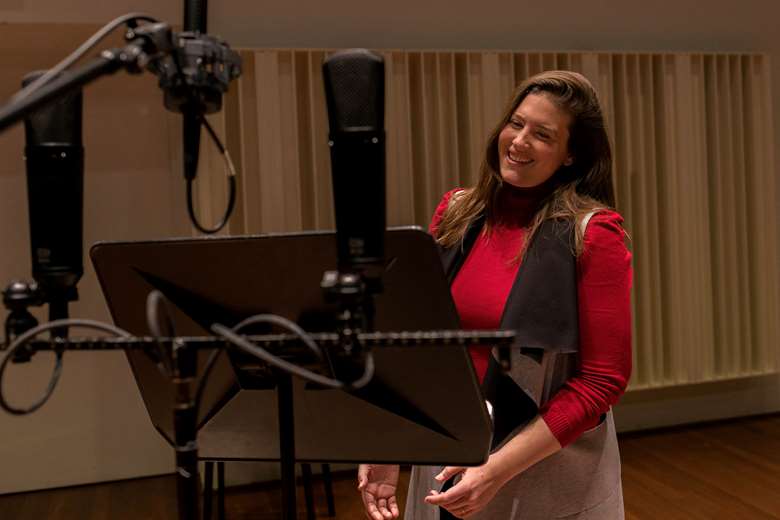Dichterliebe’s Daughter: Lili Boulanger’s Overlooked Masterpiece 'Clairières dans le Ciel'
Katharine Dain
Friday, November 17, 2023
'Extraordinary works of art remind us that that we’re not alone in our wonder and love and suffering'

As Lili Boulanger’s only song cycle shuddered into its final pages, I could already feel a heat gathering behind my eyes. No, no, it’s too soon, I tried to tell myself. This is hard enough to sing without tears constricting the throat. For the next few minutes, a fight ensued between soul – fast abandoning itself to the wrenching pull of the music and poetry – and body, which had a professional responsibility to deliver all the notes and words and reach the end of the recital in one piece.
The soul won.
In the summer of 2021, the pianist Sam Armstrong and I tried Clairières dans le ciel for the first time. It became apparent during rehearsal that there was more to the piece than met the eye, but the vast scope of Boulanger’s vision only truly revealed itself in performance. Written in 1914 by a 20-year-old composer fresh off her triumph as the first woman to win the Prix de Rome, the cycle remains little-known; its length and considerable technical difficulty, plus a tendency among performers to emphasize the sensuality of French music and soften its sharp corners, have often obscured the piece’s most astonishing feature: searing emotional force. Individual songs are occasionally excerpted out for their beauty, but Clairières complete, we discovered, is no perfumed trifle. It is a work of startling truth, worthy of passionate commitment.

Katharine Dain (left) and Sam Armstrong (right)
After our first attempt, we performed it many times and made it the centrepiece of an album project (Forget This Night, released today). It takes work, however, to pitch the piece. It has little name recognition even among song enthusiasts. For it to be valued as a the major contribution to the genre that it is, people really need to hear it whole and preferably live—as with any piece that asks for both concentration and surrender.
Clairières didn’t come out of nowhere. Like many great works of art, it is a doomed love story. In narrative arc and other aspects, it is a descendent of Schubert’s Die schöne Müllerin (1823) and Winterreise (1827) and Schumann’s Dichterliebe and Frauenliebe und -leben (both 1840); its contemporary cousin is Schoenberg’s Das Buch des hängenden Gärten (1908-9); it points forward to Messiaen’s Harawi (1945).
Spiritually closest perhaps to Dichterliebe, Clairières maps one person’s experience of a harrowingly intense love. The narrator (almost un-gendered except for a few adjective endings) worships a girl, loses her, and suffers acutely. We don’t learn any specifics: it’s not clear if a definitive split occurred, if she drifted away to another place or phase of life, or if she died. The love may have been one-sided, vividly flowering only in the narrator’s mind. Boulanger created her own sequence of thirteen movements from a poetry collection by Francis Jammes, and her choices (and omissions) show that her focus, like Schumann’s, was more on inner emotional fluctuations than on action or the outward manifestations of love. Some moments are as tender as Müllerin, others as psychologically splintered as Winterreise, but the piece stands firmly in the 20th century; its vulnerable exploration of a relationship’s most interior tensions – where self meets another, how possible honesty in love is or isn’t – seems modern even now.

Katharine Dain (left) and Sam Armstrong (right)
Boulanger is also innovative with time. Although the cycle’s structure seems straightforward at first glance, we slowly realize that it is a Joycean traversal of memory rather than a linear story. The first temporal dislocation occurs early, in the third song; moments of confusion, grief, and anticipation continue to intrude throughout. Jammes mixes verb tenses to reveal the disorientation of someone trying to come to terms with a great loss, and Boulanger heightens this fragmentation with abrupt musical shifts, surreal attenuations, and Leitmotif-style repetitions of emotionally-coded material.
The final song, ‘Demain fera un an,’ seems to burst out of the confines of the genre altogether, more operatic mad scene than song. The narrator returns to places where his love blossomed, lurching shockingly between dissociation, nihilistic anguish, and tender recall. The final pages contain a masterful Schumann-esque moment of nostalgic consolation. ‘J’écris,’ the narrator numbly intones: we realize that he is trying to write, to process raw experience, and five sweet bars from the first song appear, a fragment of a dream. They peter out mid-phrase, replaced by tolling low octave Ds and the song’s last refrain of despair.
I’ve sung the piece dozens of times, and it’s still really hard not to cry at the end.
Extraordinary works of art remind us that that we’re not alone in our wonder and love and suffering. The song cycle will never be the most lucrative genre, but it is one of the most personal and revealing. Singers, pianists, and listeners know the privilege of living with the Schubert and Schumann cycles over a long period; Fischer-Dieskau recorded Dichterliebe multiple times with different partners in different decades. Revisiting a piece that has marked us deeply, we see ourselves reflected in the poetry differently from year to year; we notice different physical possibilities emerge as our bodies change; we move from the passionate sensitivities of adolescence (such as Lili embodied when she wrote her only song cycle) to greater grace and understanding.
Clairières dans le ciel is, in our opinion, absolutely as worthy of long-term investment from performers and audience as its more famous predecessors. We commend it highly to anyone who has ever wept through Dichterliebe or Winterreise, and we’re already looking forward to going back into the studio for a 25th-anniversary recording in 2048 – grayer, but no less moved by its raw, tender beauty as we were the first time.








